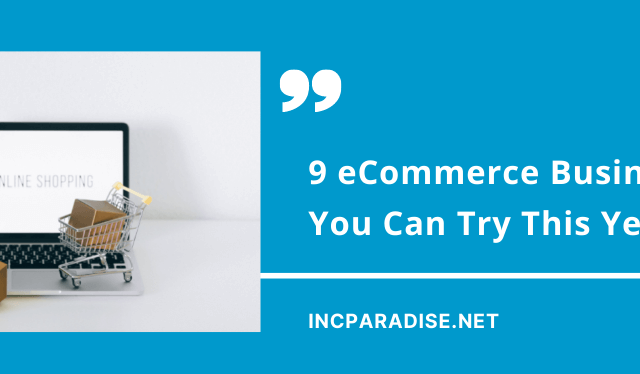E-commerce provides a great way to start a business without the high overhead associated with traditional brick-and-mortar operations. However, imagining a store and actually opening one are two completely different things. It’s easy to fantasize about a future where customers swarm to your company and you become a household name overnight, but getting there requires a lot of backend effort. It takes more than just buying a domain and running a successful eCommerce to launch a profitable online clothes store. The topic you choose, the branding you design, the quality of not only your apparel products but also your website, customer service, and fulfillment plans all have a role in how successful your business is.

Starting a Clothing Business
Starting an online apparel business from the ground up can be daunting. But once you start understanding the business and its notion, it is extremely rewarding. According to research, the online clothes sector is booming, with year-over-year growth. When you start selling clothes online, you’ll need to sign up for an eCommerce plan so you can connect to payment processors and accept payments from clients. Online shop builders are not only simple and inexpensive to use, but they also take care of all the technical details so you don’t have to. Without having to worry about security updates or hacking dangers, you can start selling clothes online in no time.
Online clothing industry outlook
The US online clothing market is experiencing robust growth, driven by evolving consumer expectations and technological innovations. Valued at approximately $145 billion in 2025, the U.S. fashion e-commerce market is projected to expand at a compound annual growth rate (CAGR) of about 12.8% through 2032, reflecting strong demand for convenience, variety, and personalized shopping experiences.
Technologies such as AI-powered product recommendations, virtual try-ons, and augmented reality fitting rooms are becoming standard, enhancing customer engagement and satisfaction. Mobile commerce dominates, with a majority of US shoppers, particularly Gen Z and millennials, favoring smartphone shopping combined with digital wallets for ease and speed.
Sustainability and ethical production practices are key factors influencing buying decisions, as American consumers increasingly value transparency and eco-conscious sourcing. The resale clothing market is also flourishing, expected to reach $40 billion by 2029, growing faster than traditional retail fashion.
The competitive landscape is intense, with direct-to-consumer (DTC) brands, boutique designers, and retail giants embracing omnichannel strategies that integrate online and in-store experiences. Customer loyalty hinges on offering unique brand stories, superior service, and leveraging data for timely trend adaptation.
Steps to Start an Online Clothing Business
Starting an online business requires a lot of planning, organizing, and allocation of funds. However, one needs to keep in mind the following to run an online clothing store as there is a lot of competition in this field.
Do market research and find the target market
There are numerous free and paid services available to ensure that your clothes have a market need. Market research is divided into two types: primary market research, which is data that you collect yourself, and secondary market research, which is data that you obtain from other sources. Search Google Trends for certain things to learn what’s hot and what’s not. Investigate Facebook Analytics to learn more about the likes, interests, and habits of potential customers or target audiences (more on that soon).
Conduct competitive research on other online apparel brands to see what people like and dislike. It is extremely important to find your target market because your target audience is a defined group or groups of people who will need or want your products. Establishing a need and determining a target audience go hand in hand. Those are the people who make up your target market. These are the people you’ll be interacting with and connecting with daily. The better you understand those folks, the more likely you are to gain and keep their business.
Prepare a business plan
A strong fashion business plan outlines: Who you are as a firm, including your team, mission statement, and products? What you’re aiming for, including precise, executable, and quantifiable business objectives? Why do you believe the company will succeed? (This is where your market research comes in.) How you intend to achieve your business objectives, supported by concrete measures and methods. Your apparel business plan should ideally span the first three to five years of your company.
Prepare your business model
Choosing a business model is an important component of establishing an online retail company plan. Clothing can be sold in a variety of methods, so think about how you’ll get started and what model will allow you to develop the most quickly without draining your financial account. There are four popular options in the e-commerce apparel retail world: On-demand printing, custom cut and sew, and Dropshipping of private label apparel.
Decide on clothing items to sell
You must first pick the garment or clothing niche you want to offer. This helps you choose products and build your business plan focused on the customers you want to attract. Specializing allows you to position your store uniquely. Be very specific about your niche. This makes it easier to find and market to your potential customers. It also helps you create a product list that appeals to your target market. This reduces competition and increases the chances of long-term customer loyalty.
Plan the supply chain
Supply chain planning (SCP) is a forward-looking process. It coordinates assets to maximize the flow of goods, services, and information. This flow goes from supplier to consumer. SCP also balances supply and demand.
A good foundation for a synchronized supply chain is a trustworthy “one-number plan” combined with maximized in-season sell-through. Customers may be segmented, and assortments can be localized, allowing apparel firms to maximize full-price sell-through. As garment firms seek the most intelligent way to develop, source, manufacture, and deliver a broader range of products to more consumers, segmentation places a greater emphasis on the supply chain. Companies that are struggling to manage their supply chains effectively must look beyond spreadsheets to improve their planning, sourcing, and replenishment.
Create your online store
A solid e-commerce site is simple to navigate, simple to use, and adheres to the branding you want for your site. For those who are unfamiliar with site design, this may appear to be a hard undertaking, but depending on the e-commerce platform chosen, finding the correct fit can be relatively simple. You’re ready to post your products for sale once you’ve constructed the framework of your site. Your domain name should be compatible with your company name, as well as your long-term business objectives and products.
This isn’t as easy as it sounds. Nevertheless, how well you display your products, the quality of your descriptions, and even the navigation of your eCommerce page can all have a direct impact on your sales.
Register your business
The type of registration you’ll require depends on your location and business structure. Have a brand name, which might be a company name, a domain name, a product name, a slogan, a logo, a word, a design, or any other element that distinguishes a product or service from others. The process of branding begins with the selection of a business name. A business name is the legal name of the entity. It appears on the business’s bank account, tax registration, legal documents, and many other things. As more people look online for businesses, products, and services, branding begins with domain registration. All businesses now demand an online presence, and it is critical to secure the required domain name that is synonymous with the firm.
Start branding and marketing your store
Your store is up and running. Your product descriptions and photographs are fantastic, and your landing page is well-optimized, but where are your customers? The most excellent approach to get them to you is to employ excellent marketing. These three essential items are the impetus you’ll need to get your shop up and running. Email marketing is one of the most effective ways to target customers, delivering considerable value at a cheap cost (email marketing has an average ROI of $42 per dollar spent). One of the most significant techniques for beginning a new business is to use social media. From your product descriptions to your blog, everything you put on the web should speak to your overarching objective as a company.
Need Any Help in Forming Your Online Business?
Starting an online business can seem daunting initially, as it involves a lot of steps, planning, and knowledge about the market. There can be times when the business owner may not have prior knowledge about the registration process and setting up a business online. In this case, IncParadise may assist in the registration of a business (LLC/Corporation) with the SOS, as well as mail forwarding services if they plan to operate their business from home. We can also assist in the management of their business, such as filing yearly reports, and so on. Fill out the signup form and get a free consultation from us.
Last updated: August 2025






